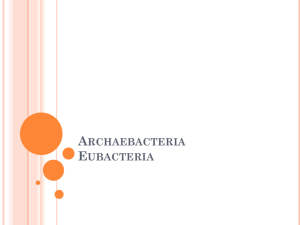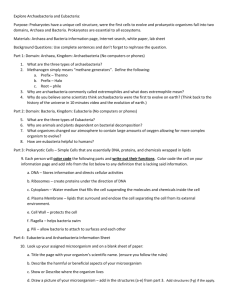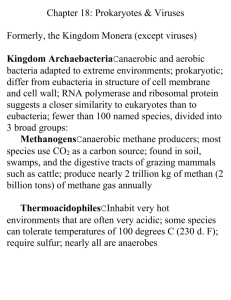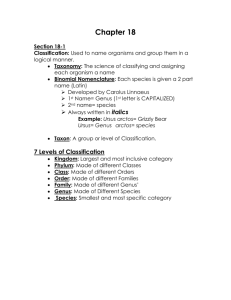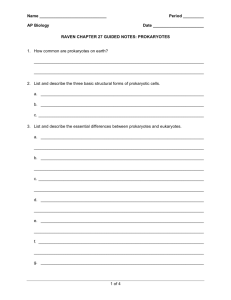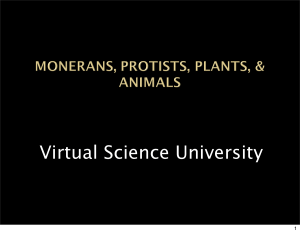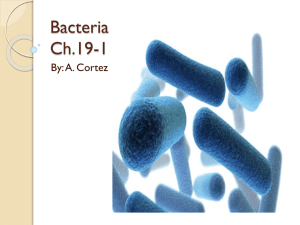Bacteria and Viruses
advertisement
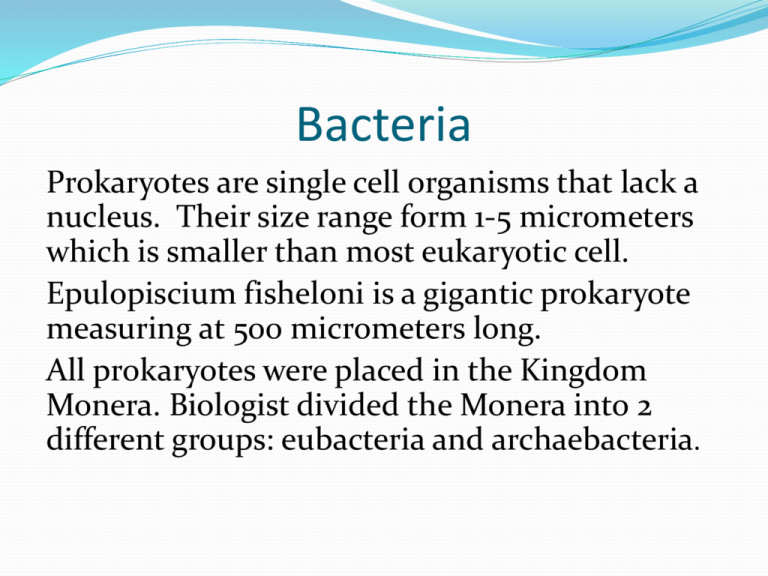
Bacteria Prokaryotes are single cell organisms that lack a nucleus. Their size range form 1-5 micrometers which is smaller than most eukaryotic cell. Epulopiscium fisheloni is a gigantic prokaryote measuring at 500 micrometers long. All prokaryotes were placed in the Kingdom Monera. Biologist divided the Monera into 2 different groups: eubacteria and archaebacteria. Eubacteria Is the larger of the 2 Kingdoms Freshwater, salt water, on land and within the human body. Example: E. Coli lives in the human intestines. Surrounded by a cell wall that protects the cell from injury and determines its shape. The cell wall of eubacteria contains peptidoglycan, a carbohydrate. Inside the cell wall is a cell membrane that surrounds the cytoplasm. Some eubacteria have a second, membrane outside the cell membrane making it especially resistant to damage. Archaebacteria Looks similar to eubacteria Equally small, lack nuclei, have cell walls but chemically different Archaebacteria lacks the peptidoglycan of eubacteria and have different membrane lipids. The DNA sequences of key archaebacteria genes are more like those of eukaryotes than those of eubacteria. Archaebacteria Archaebacteria may be ancestors of eukaryotes. They live in extremely hard environments that produce methane gas. Methogens live in oxygen-free environments such as mud and digestive tracts of animals. They live in extremely salty environments such as Utah Great Salt Lakes, hot springs where the temperatures approach the boiling point of water. Identifying Prokaryotes Prokaryotes are identified by characteristics such as shape, chemical nature of their cell walls, the way they move, and the way they obtain energy. Shapes bacilli are rod shaped cocci are spherical Sprilla spiral and corkscrew Identifying Prokaryotes Cell Walls - 2 different types Gram Staining is used to tell them apart Violet (primary stain) is applied first. It stains the peptidoglycan cell wall. The alcohol treatment wash out the stain. Gram positive bacteria have thick peptidoglycan walls which retains the dark col0r. Gram Negative bacteria have thinner walls inside an outer lipid layer. Alcohol dissolves th lipid and removes dye from the walls of the bacteria. Red (counter stain) makes bacteria appear pink and light red. Movement of the Prokaryotes Some prokaryotes do not move. Others are propelled by flagella, whiplike structures use for movement. Prokaryotes lash, snake or spiral forward, other glide slowly along a layer of slimelike material they secrete. Metabolic Diversity Most prokaryotes are heterotrophs, they get their energy from consuming organic molecules made by other organisms. Autotrophs make their own food from inorganic molecules. Heterotrophs take in organic molecules for both energy and supply of carbon called chemoheterotrophs. Metabolic Diversity Staphylococcus aureus releases toxins that cause food poisoning. Photoheterotrophs are photosynthetic and use sunlight for energy. They also take in organic compounds as a carbon source. Autotrophs Use light energy to convert carbon dioxide and water to carbon compounds and oxygen in a process similar to that used by green plants. Found in surfaces of lakes, streams, and oceans. Cyanobacteria is a bluish pigment and chlorophyll a the key pigment in photosynthesis. They are found in freshwater, salt water, and even on land. Cyanobacteria is the first species to recolonize the site of a natural disaster such as volcanic eruption. Chemoautotrophs performs chemosynthesis makes organic carbon molecules from carbon dioxide do not require light as a source of energy use energy directly from chemical reactions involving ammonia, hydrogen sulfide, nitrites, sulfur and iron some live deep in the darkness of the ocean. They obtain energy from hydrogen sulfide gas that flows from the hydrothermal vents on the ocean floor. Growth and Reproduction Binary Fission is when the bacterium nearly double in size, it replicates its DNA and divides in half producing 2 identical daughter cells. It does not involve the exchange or recombination of genetic information. It is an asexual form of reproduction. Conjugation is the exchange of genetic information by a process. A hollow bridge forms between 2 bacterial cells. The genes moves from one cell to the other. The transfer of genetic information increases genetic diversity in populations of bacteria. Spore Formation Spore Formation is when growth conditions become unfavorable many bacteria will form structures called spores. Endospores is when bacterium produces a thick internal wall that encloses DNA and a portion of its cytoplasm. Spores can remain dormant for months or even years while waiting for more favorable growth conditions. When conditions improve the endospore will germinate and bacterium will begin to grow. They can survive harsh conditions including extreme heat, dryness of lack of nutrients.
